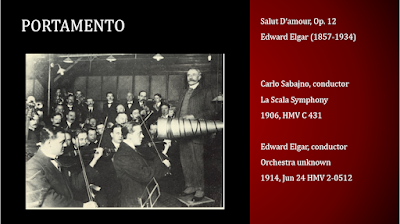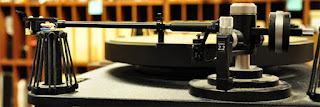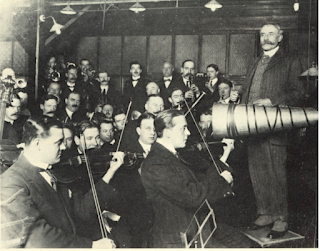Introduction
Inspiration, not replication. This is the tagline that best describes the conception and realization of the American Baroque Orchestra's first romantic-era performance/recording project from 2024. The guiding source was the voluminous collection of early sound recordings at Yale University that conveys a fascinating array of romantic-era performance practices. These recordings reveal stylistic gestures that have been diminished or discarded in favor of modernism and the music that comes with it. The goal was to be inspired by these gestures and allow them a rekindled and bold presence in each piece, not to re-exist in the past, but to reclaim, reconsider, and explore certain manners of expression that mattered in their time and arguably still matter today.
Preparing for musical revitalization logically involves degrees of replication: musicians mimicking what is heard on early recordings — ideally supported by written sources — to get a feel for the type of stylistic performance that is often overlooked in modernist musical training. Early recordings, in other words, begin as instrumental and vocal instructors. And that process, if approached thoughtfully, can yield insight. Replication, however, runs its course fairly quickly. After all, no matter the circumstances, listeners want -- in fact demand -- one thing as a prerequisite for sustained interest at a concert or in a recording: inspiration. However intangible as that may be and however difficult it can be to pin down and describe, most people can sense when a piece of music is being performed from the musician's soul and when it is merely a recitation of pitch and rhythm that has been done the same way by others.
Creative revitalization, though (emphasis on "creative"), makes impactful inspiration raw. It is risky. It prioritizes adventure over popularity. Listeners may want to sense inspiration, but they often will initially shun what they perceive as radical. Fresh interpretation does not have to be all that different, and contradicting the excessively familiar can be hard to swallow (even if stylistic variation, deep down, is a fascinating prospect). Persistence, re-packaging, and the ability to move simultaneously at warp speed and at a snail's pace can eventually win most people over. This also means never to concretize the revived styles in certain pieces of music but to continue to tweak, renew, rethink, and try again (and again). Many listeners appreciate such flexibility and variety when they realize the world of possibility still exists and change is variable. If Willem Mengelberg's use of orchestral portamento on early recordings just feels like too much, other conductors used less (even Mengelberg himself). The choice is there, but Mengelberg is not invalidated if the ensemble chooses a different route.
Such exploratory leadership demands immersion. In this case, listening to a dozen or two historical recordings opens the door just a crack. It takes hundreds, maybe thousands, of 78 rpm cylinders and discs to get a real sense of the broad, complex, and multi-faceted performance landscape in the romantic era through this particular lens. In this sense, early sound recordings speak as a multi-faceted chorus to nurture the reimagining of romantic music performance today with all of its inherent possibilities. Performers simply have more stylistic vocabulary to choose from than modernist pedagogy has let on.
The works
Fewer than a dozen shorter works were chosen for this project to serve as an exhibit of stylistic possibility through musical contrast and variation. The ensemble consisted of twelve string players who perform both in the early music and modern worlds. Two of the works on this recording are originally written for strings, and the others are adaptations. Most of the stylistic gestures were indicated ahead of time in the parts -- though the degrees to which they were rendered were decided in rehearsal -- while a number of expressive instances, especially additional portamenti (or slides), also were crafted in rehearsal. The works were recorded in live performance. What is heard in Melodrama, in other words, is music that interacted with an audience.
The recording begins with Robert Schumann's "Soldier's March" from Album for the Young. The harmonic structure provided an opportunity to accent certain strong sonorities, which gives a greater sense of arc to the phrasing. At the concert, acting as a sort of prelude, this piece segued into the Rosamunde ballet music. In the recording, however, it stands on its own.
Tr. 1 Soldier's March (R. Schumann)
Music for dance is permeated with rhythmic vitality, but it does not necessarily need to be shaped by an unyielding pulse (especially when performed in concert without dance). Our rendition of the Ballet Music no. 2 from Franz Schubert's incidental music to Rosamunde applies touches of tempo flexibility at phrase endings and section shifts, along with some playfully conceived portamento. The midpoint of the dance is taken just a bit slower to highlight its contrast and charm, and the coda pushes the tempo forward a bit to enhance the excitement of the ending. Unregulated by exact synchronicity, each section embraces the tempo shifts within the confines of their individual parts.
Tr. 2 Ballet music no. 2 from Rosamunde (F. Schubert)
The "Andante amorevole" from Felix Mendelssohn's Seventh String Symphony, a work written sometime between the ages of twelve and fourteen, begins tenderly with a dialogue between the first and second violins, later joined by violas. This allows for portamento between some of the intervals, along with slight stretches of the phrases, to add inflection in the lines as would be done even in gentle speech. This supports and enhances the loving (i.e. amorevole) feeling of the work's opening. Just after the cellos join in, enabling a shift from D to A major, a new theme, boldly in F major, is introduced. Here we quicken the tempo to highlight the slight boost of energy and momentum that comes from the new theme. Both themes reappear as the movement continues, affording the same type of stylistic exploration and enhancement. A little over a dozen measures before the end, we render a phrase of six eighth notes as a hemiola to bring out the chromatic harmonies.
Tr. 3 Andante amorevole from String Symphony no. 7 (F. Mendelssohn)
Edvard Grieg's "Solveigs song" from his second Peer Gynt suite is the only work on this recording where portamento (i.e. "glissando") is indicated. It appears for all instrumental sections, one after the other, in the work's introduction and ending. The ensemble uses a touch of added portamento throughout the rest of the work, but in a delicate and subtle manner, so as not to overshadow the prominent glissandi in the score. Much of the tempo flexibility is also written in the score, though the extent to which any instance of it is rendered of course was decided by the ensemble. These gestures are all intended to serve the atmospheric elements of the music through the muted strings.
Tr. 4 Solveig's Song from Peer Gynt Suite no. 2 (E. Grieg)
Time feels suspended in Rachmaninoff's "Tebe Poyem" ("We praise/sing to You") in this string adaptation from his Divine Liturgy of St. John Chrysostom. The solemnity of the liturgical act that this sacred hymn accompanies -- the transformation of the holy gifts -- is actualized through gently and patiently moving notes, measure to measure, until a reverent viola solo appears, seemingly out of nowhere, to bring this moment in music to a close. It is profundity through relative -- and difficult -- simplicity. The calmness of breath is all that matters.
Tr. 5 Tebe Poyem fronm Divine Liturgy of St. John Crysostom (S. Rachmaninff)
Prodigious violinist Erika Morini appears to be the first person to have recorded Svendsen's Romanze in 1922. It is with piano and has significant cuts so as to fit on a 12-inch side. Nevertheless, the listener gets a sense of the scope and expressive warmth of the piece. In our recording, concertmaster Edson Scheid is the soloist in our fuller version. Rather than insisting on complete vertical alignment between soloist and ensemble, the violin solo steps slightly in front of the other players and brings the ensemble along with him, as is so often heard on early recordings of instrumental soloists with ensemble (similar to the asynchronistic playing that is heard between the right and left hands in numerous early recordings of pianists). In a piece like this, arguably, the expression is enhanced when the soloist and ensemble are together, but not always exactly together. It is nothing that can be enacted purposefully through rehearsal instruction. It instead happens as a result of a certain momentum of freedom whereby the soloist can explore each phrase and nuance, and the ensemble then responds, sometimes taking an extra split second to react.
This "Melodrama" from Tchaikovsky's Snow Maiden serves as the title track. While the composer was more than capable of filling his scores with ample expressive instructions, curiously this piece is minimally marked. The beginning of the score includes a tempo description, the dynamic of piano, and con sordino to indicate the use of mutes. No other expressive markings appear until the codetta, which adds pianissimo and has a diminuendo hairpin (which also can be interpreted as a slowing down). The music itself, however, demands much more expression, sensitivity, and attention to style than such minimal instruction would imply. While the melody clearly speaks through the first violins, there is an undeniable contrapuntal relationship with the other instrumental voices, especially between the first and second violins in the opening measures, but among all instruments by the ninth measure. As a result, each instrumental section was allowed, even encouraged, to play their parts in a fully expressive manner, without having to yield to a hierarchy completely favoring the first violins or the rigidness of the vertical pulse. In a sense, each section was independent while yielding to the other parts in a dialogue of give and take. The pulse itself was pliable, enabling expressive exploration beyond the need for rigid alignment, and ample portamento helps to shape the thought-phrases and invite heartfelt emotion.
Tr. 7 Melodrama (P. Tchaikovsky)
The waltz is one of the most important dance and musical forms to evolve in the romantic era, and Tchaikovsky's Sleeping Beauty's waltz is a quintessential example and our final track. The listener cannot help but yield to a lilting and floating-like feeling, whether or not the ballet is taking place on stage. In deference to its structure, tempo fluctuation is minimal throughout to honor the importance of the gentle but essential rhythmic pulse. We add portamento to help the melody speak in a seamless legato with a sense of heartfelt elegance, but also, especially in the middle section, to enhance the fairy tale quality of the work and encourage imagination.
Tr. 8 Waltz from Sleeping Beauty (P. Tchaikovsky)
We hope this recording encourages the spirit of stylistic revitalization and a new openness to musical possibility.



















